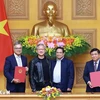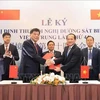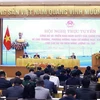The recent run of improvements in Vietnamese manufacturing business conditions continued in February, with further rises in output, new orders, and employment recorded, according to HSBC's latest monthly report.
Supply shortages led to an increase in input costs during the month, but the rate of inflation remained broadly stable and panellists left their output prices unchanged in an effort to stimulate new business.
The headline seasonally adjusted Purchasing Managers' Index (PMI) – a composite indicator designed to provide a single-figure snapshot of operating conditions in the manufacturing economy – fell to 51 in February from 52.1 in January, but still signalling an improvement in operating conditions in the sector.
Business conditions have improved in each of the past six months.
Vietnamese manufacturing firms recorded a further increase in production during February though the rate of expansion eased to the slowest since last October. Where output did rise, this was linked by respondents to higher new orders.
Overall new business rose modestly. New orders have increased in five of the past six months. Some respondents reported improved client demand. On the other hand, new export orders fell during the month, following a modest increase at the start of the year.
A slower rise in new work contributed to a depletion of outstanding business during February. The rate of decline in backlogs quickened to the strongest since last August. Firms partly met new orders through the delivery of finished goods to clients. As a result, post-production inventories decreased. The rate of depletion was sharp and the fastest in the history of the survey which began in April 2011.
Increased workloads led manufacturers to raise employment, though, as with output and new orders, the rate of growth slowed. Staffing levels have now risen in each of the past seven months.
Another solid increase in input prices was recorded in February, with respondents mainly linking inflation to a shortage of materials at suppliers.
The rate of inflation remained broadly in line with those seen in recent months. Despite the rise in input prices, manufacturers left their product prices unchanged as part of efforts to maintain sales growth.
Suppliers' delivery times were unchanged in February. While some panellists indicated that requests for faster deliveries had been met by suppliers, others indicated that material shortages had led to longer lead times.
Firms continued to raise their input purchases at a solid pace, with this sixth successive monthly increase in purchasing activity partly reflective of attempts to build stocks for the future. This had the effect of reducing the pace of depletion of stocks, which fell only fractionally.
An analysis by HSBC of trade found that, according to most estimates, Vietnam will be one country to benefit greatly from the Trans-Pacific Partnership (TPP), with market access to the US and lower tariffs for its manufactured goods as key points.
In per capita GDP terms, Vietnam is the poorest of the 12 in the negotiations. But Vietnam's ambition is clear: to provide as many stable jobs for its workforce as possible, and increasing market access and bolstering its manufacturing sector are the way forward.
While negotiators are hopeful that a draft will be ready in April, the ministerial talks held in Singapore did not end with a deal.
While businesses in Vietnam eagerly await TPP developments, export-oriented firms continue to press on. In the first two months exports increased 12.3 percent despite lower demand in China and unseasonably cold weather in the US, which dragged down consumption.
The below 50 HSBC PMIs for China and slowing growth indicators in the US due to the weather and rising interest rates dampened some demand for Vietnamese goods.
But the bank's US economist expects growth to be stronger in 2014 than 2013. The more positive news flow from the eurozone should bolster demand for goods in the coming months. While China demand may slow, Vietnam's major export partners are the EU and the US.
Import of inputs has risen sharply in 2014 in comparison with the previous two years.
Cotton, sewing materials, garments, and machinery and spare parts imports accelerated. While demand from abroad has slowed, the rise in input import growth coupled with stronger orders than inventories suggests that output will continue to be robust.
The strong increase in disbursed FDI should counterbalance any weakness in external demand.
Manufacturing exports certainly are becoming more important. But commodity prices, too, matter for export value.-VNA
Supply shortages led to an increase in input costs during the month, but the rate of inflation remained broadly stable and panellists left their output prices unchanged in an effort to stimulate new business.
The headline seasonally adjusted Purchasing Managers' Index (PMI) – a composite indicator designed to provide a single-figure snapshot of operating conditions in the manufacturing economy – fell to 51 in February from 52.1 in January, but still signalling an improvement in operating conditions in the sector.
Business conditions have improved in each of the past six months.
Vietnamese manufacturing firms recorded a further increase in production during February though the rate of expansion eased to the slowest since last October. Where output did rise, this was linked by respondents to higher new orders.
Overall new business rose modestly. New orders have increased in five of the past six months. Some respondents reported improved client demand. On the other hand, new export orders fell during the month, following a modest increase at the start of the year.
A slower rise in new work contributed to a depletion of outstanding business during February. The rate of decline in backlogs quickened to the strongest since last August. Firms partly met new orders through the delivery of finished goods to clients. As a result, post-production inventories decreased. The rate of depletion was sharp and the fastest in the history of the survey which began in April 2011.
Increased workloads led manufacturers to raise employment, though, as with output and new orders, the rate of growth slowed. Staffing levels have now risen in each of the past seven months.
Another solid increase in input prices was recorded in February, with respondents mainly linking inflation to a shortage of materials at suppliers.
The rate of inflation remained broadly in line with those seen in recent months. Despite the rise in input prices, manufacturers left their product prices unchanged as part of efforts to maintain sales growth.
Suppliers' delivery times were unchanged in February. While some panellists indicated that requests for faster deliveries had been met by suppliers, others indicated that material shortages had led to longer lead times.
Firms continued to raise their input purchases at a solid pace, with this sixth successive monthly increase in purchasing activity partly reflective of attempts to build stocks for the future. This had the effect of reducing the pace of depletion of stocks, which fell only fractionally.
An analysis by HSBC of trade found that, according to most estimates, Vietnam will be one country to benefit greatly from the Trans-Pacific Partnership (TPP), with market access to the US and lower tariffs for its manufactured goods as key points.
In per capita GDP terms, Vietnam is the poorest of the 12 in the negotiations. But Vietnam's ambition is clear: to provide as many stable jobs for its workforce as possible, and increasing market access and bolstering its manufacturing sector are the way forward.
While negotiators are hopeful that a draft will be ready in April, the ministerial talks held in Singapore did not end with a deal.
While businesses in Vietnam eagerly await TPP developments, export-oriented firms continue to press on. In the first two months exports increased 12.3 percent despite lower demand in China and unseasonably cold weather in the US, which dragged down consumption.
The below 50 HSBC PMIs for China and slowing growth indicators in the US due to the weather and rising interest rates dampened some demand for Vietnamese goods.
But the bank's US economist expects growth to be stronger in 2014 than 2013. The more positive news flow from the eurozone should bolster demand for goods in the coming months. While China demand may slow, Vietnam's major export partners are the EU and the US.
Import of inputs has risen sharply in 2014 in comparison with the previous two years.
Cotton, sewing materials, garments, and machinery and spare parts imports accelerated. While demand from abroad has slowed, the rise in input import growth coupled with stronger orders than inventories suggests that output will continue to be robust.
The strong increase in disbursed FDI should counterbalance any weakness in external demand.
Manufacturing exports certainly are becoming more important. But commodity prices, too, matter for export value.-VNA



















